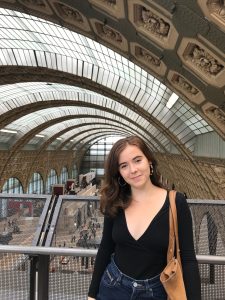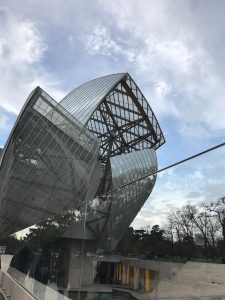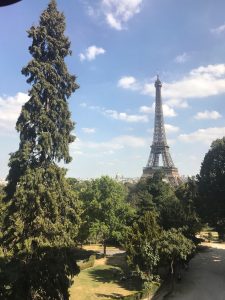Ce semestre, j’ai commencé un cours d’architecture en parallèle de mes études. C’est un sujet que je voudrais explorer depuis longtemps, et finalement l’opportunité s’est présentée. J’apprendrai de l’histoire de l’architecture de 1850 à nos jours, avec un accent particulier sur les styles modernistes. J’ai déjà appris que pour appréhender l’évolution de l’architecture et de l’urbanisme, nous re-situerons les bâtiments dans leur contexte historique. Dans ce blog, je vais montrer (avec les images ci-joint) et décrire trois musées que je trouve intéressants dans contexte de Paris et l’architecture plus généralement. 
Premièrement, le Centre Georges Pompidou est un musée contemporain dessiné par les deux architectes Renzo Piano et Richard Roger au cœur de Paris. Même s’il a été construit en 1977, ça reste qu’il fait souvent l’objet d’opinions polarisantes – les gens l’aiment ou le détestent souvent ! Il est composé de quatre couleurs différentes qui symbolisent différents composants appartenant au bâtiment. D’abord, le bleu pour les circulations d’air (climatisation). Puis, le jaune pour les circulations électriques et le vert pour la circulation d’eau. Enfin, le rouge pour la circulation des personnes (escalators et ascenseurs). Un exemple du modernisme à côté des rues anciennes du Marais, le Centre George Pompidou se distingue par son architecture mécanique et son usage de couleur et l’espace.
Ouverture au public en 2014, la Fondation Louis Vuitton (dessiné par Frank Gehry) est un autre musée d’art moderne avec un bâtiment unique. Ce bâtiment situé à l’Ouest de Paris témoigne des innovations que la technologie permet au sein de filière de l’architecture. Le bâtiment a la forme d’un iceberg en verre alors ceux qui fréquentent le musée regardant la lumière changent de début à la fin de la journée. L’architecture représente l’évolution constante de l’art et les artistes qui restent dans les murs du musée lui-même.
Finalement, le musée d’Orsay abrite certaines des plus grandes œuvres d’art de notre temps. Pourtant l’architecture du musée est une merveille en soi. Le bâtiment est converti d’une gare ancienne. Il est une combinaison des techniques de constructions de la 1800s et les variété de matériaux que a devient disponible à l’époque. Les horloges géantes sont présentes dans tout le musée, aidant les visiteurs à garder l’heure comme ils le faisaient autrefois en prenant les trains. Jusqu’à aujourd’hui, le toit reste recouvert d’arcs métalliques et des fenêtres verres de la gare ancienne.
This semester, I started an architecture course alongside my studies. This is a topic that I’ve wanted to explore for a long time, and finally the opportunity has presented itself. I will learn about the history of architecture from 1850 to present, with a particular emphasis on modernist styles. I have already learned that to understand the evolution of architecture and urban-planning, we have to re-situate buildings within their historical context. In this blog I will show (with attached images) and describe three museums that I find interesting in the context of Paris and architecture more generally.
Firstly, the Center Georges Pompidou is a contemporary museum designed by the two architects Renzo Piano and Richard Roger in the heart of Paris. Even though it was built in 1977, it is still often subject to polarised opinions – people often love it or hate it! It is made up of four different colours which symbolise different components of the building. First, blue for air circulation (air conditioning). Then, yellow for electrical circulation and green for water circulation. Finally, red for the movement of people (escalators and elevators). An example of modernism alongside the ancient streets of the Marais, the George Pompidou Center stands out for its mechanical architecture and its use of colour and space.
Opening to the public in 2014, the Louis Vuitton Foundation (designed by Frank Gehry) is another modern art museum with a unique building. Located to the west of Paris, this building demonstrates the innovations that technology allows within the architectural sector. The building is shaped like a glass iceberg so those who attend the museum watching the light change from the beginning to the end of the day. The architecture represents the constant evolution of art and the artists who remain within the walls of the museum itself.
Finally, the Musée d’Orsay is home to some of the greatest works of art of our time. Yet the architecture of the museum is a marvel in itself. The building is converted from an old train station. It is a combination of construction techniques from the 1800s and the variety of materials that became available at the time. Giant clocks can be found throughout the museum, helping visitors keep time as they once did while riding trains. To this day, the roof remains covered with metal arches and glass windows from the old station.
